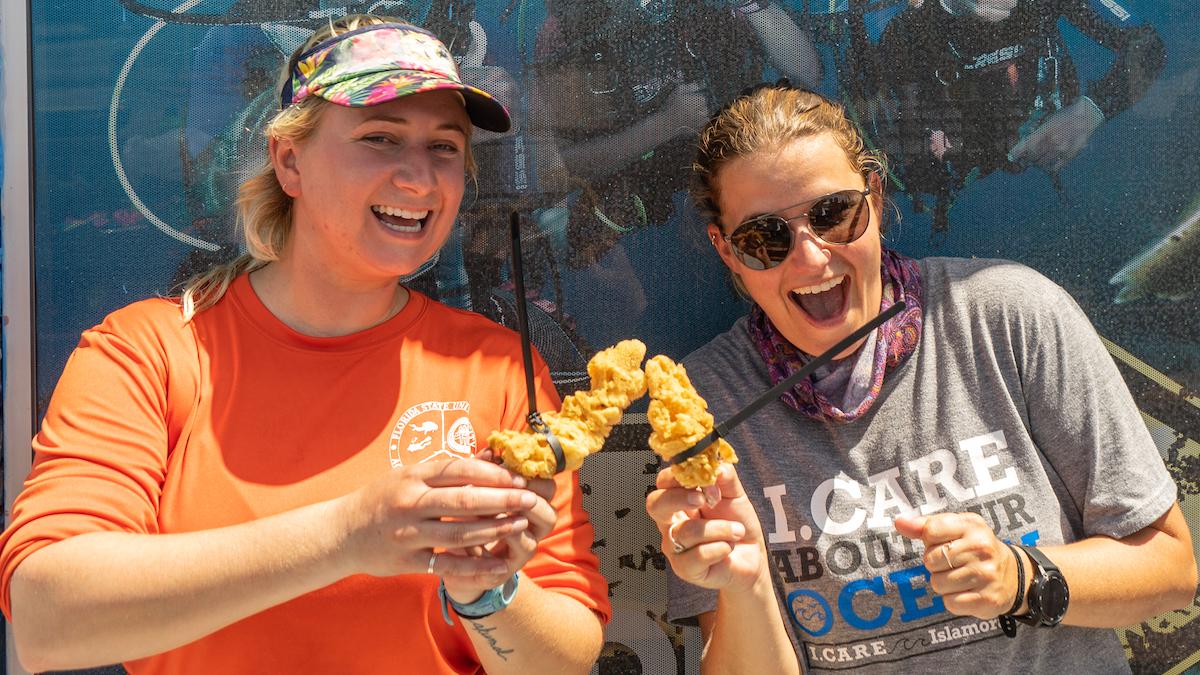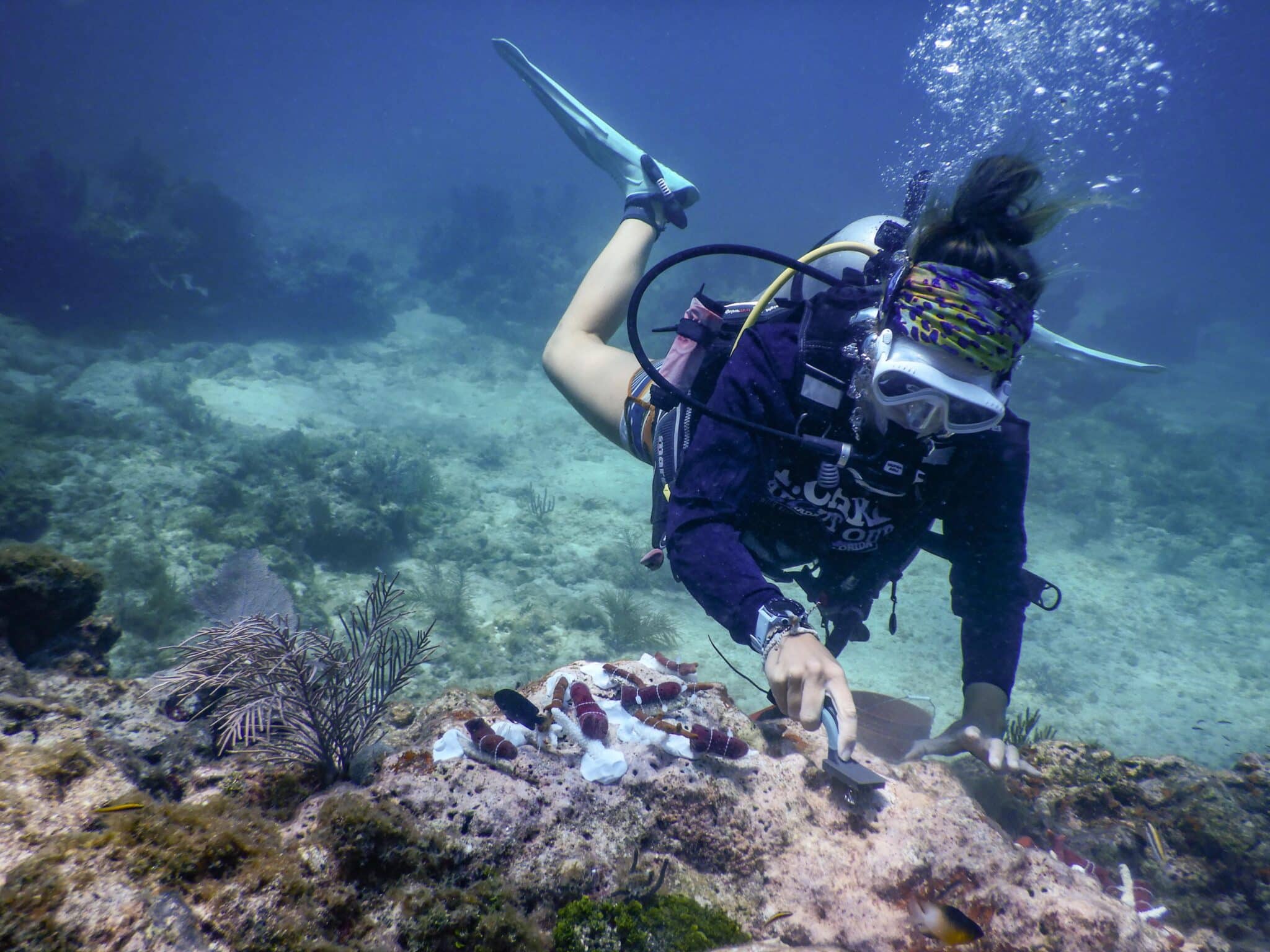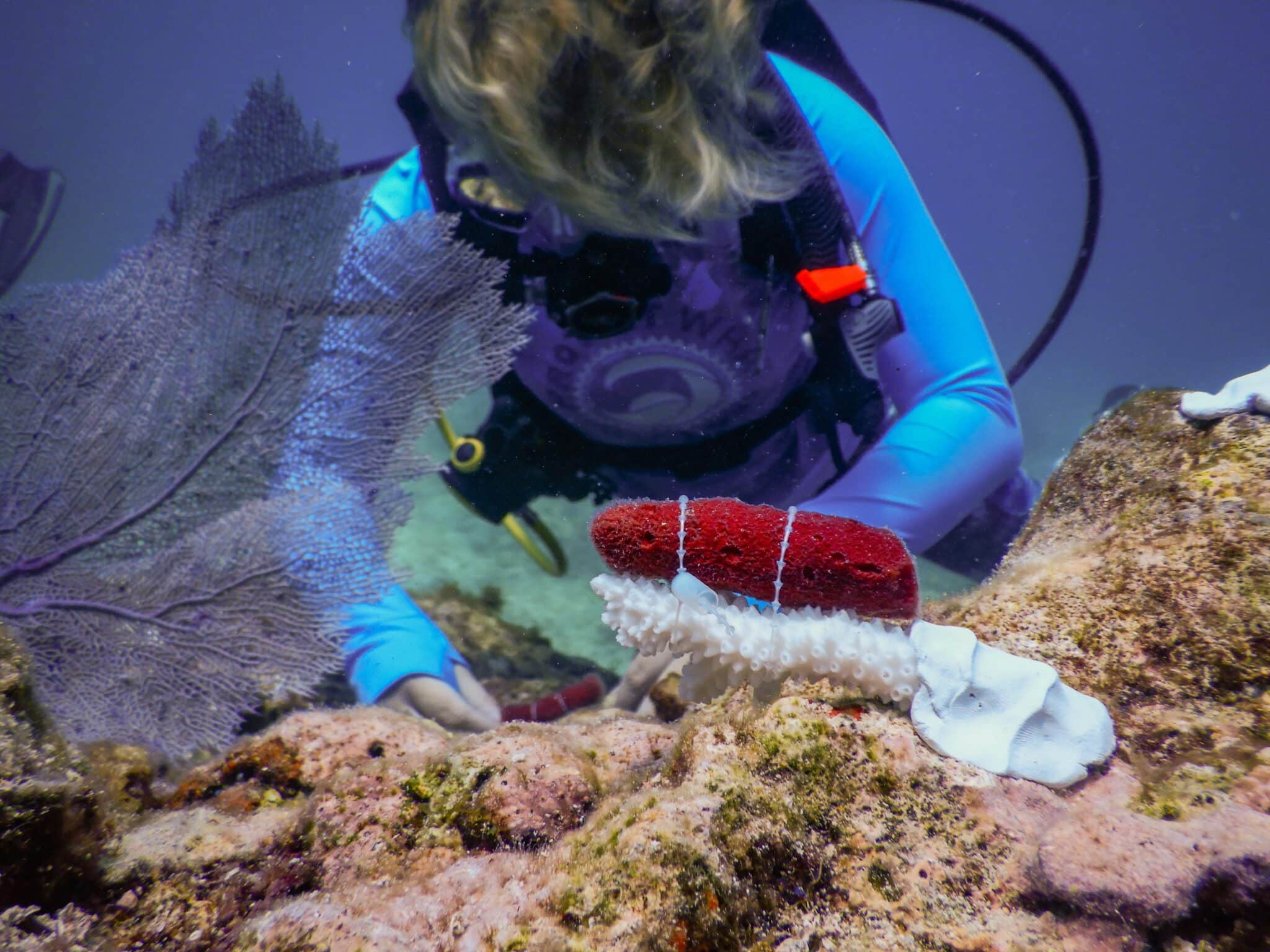
Meet ‘Sponge Bobbie,’ the Marine Biologist Using Sponges to Save Coral Reefs

We’ve all heard about SpongeBob SquarePants, the mischievous yellow sponge cartoon character who lives in a pineapple on the seafloor. Now, meet Bobbie “Sponge Bobbie” Renfro, a Ph.D. candidate at Florida State University in biological sciences and coral reef ecology, with a specialty in sponges, naturally!
Quirky naming coincidences aside, her research is anything but kiddish or silly. In fact, it could prove to be a vital but often overlooked factor in coral restoration efforts.
In the Florida Keys, a deadly coral disease, poor water quality, the climate crisis and other factors have put the reef in grave danger. The world’s third-largest barrier reef now has only 1-2% coral cover on its seafloor; traditionally, this measurement of reef surface covered by live stony coral hovers between 25 to 40%, NOAA reported. The governmental body estimated that 25% coral cover is necessary to support healthy reef ecosystem functions and maintain reef structure. As part of a $97 million phased project to halt the coral freefall, NOAA and its partners are taking a more holistic approach to coral restoration, representatives said at a Dec. 2019 meeting. They’re increasing coral cover by growing and then-gluing endangered corals back onto the reefs. And, they’re taking it further and considering everything from coral rescue plans to invasive algae removal to moving lobsters around to eat snails. Now, they’re ready to add sponges to the mix.
Sponges are simple aquatic invertebrate animals that have fossil records dating back approximately 600 million years, NOAA reported. They evolved alongside corals and other reef organisms and have become an integral part of the ecosystem.
Renfro described the three critical functions sponges serve on coral reefs before leading sponge restoration scuba dives in the Florida Keys. First, they’re the “Brita filter of the reef,” she said. “They make the waters crystal clear like the Caribbean.” Sponges have evolved to take in vast amounts of water daily and filter them through their cells, taking out pollutants and expelling clean, clear water.
Renfro takes water quality samples during every sponge restoration dive to determine how effective this natural filter is. She measures how much phytoplankton is present in the water because these organisms naturally take up nitrogen and phosphorous. She’ll keep a control sample with phytoplankton and one with the phytoplankton removed; she will also take measurements before and after restoration efforts. Comparing these will allow Renfro to estimate how much of those harmful nutrients restored sponges filter out.
A citizen-science diver cleans algae off the seafloor before using marine epoxy to restore sponges. Tiffany Duong / Ocean Rebels
“This tells us the baseline water quality of this reef,” Renfro told EcoWatch. “We see what the water quality was when we put the sponges down and what it will be after.”
Second, sponges are a foundational piece of the reef ecosystem. They provide habitat and substrate for invertebrates like snails and brittle stars that keep coral reef ecosystems functioning and balanced, the marine biologist explained.
According to the BBC, sponges also keep reefs alive by recycling vast amounts of organic matter — nearly ten times as much as bacteria. These nutrients feed snails, crabs and other creatures in amounts equal to all corals and algae in a reef, combined, the news report said. On nutrient-depleted coral reefs, this “sponge poop” cycles biological carbon into a form that other animals need and can use, NOAA said. “In this way, sponges protect the reef against extreme fluctuations in nutrient density, temperature, and light, benefiting the survival of other reef organisms,” the governmental organization reported.
Renfro also noted that the sponges she outplants are often food themselves for iconic angelfish and hawksbill sea turtles.
Finally, sponges are also the “glue” of the reef. As they grow, “sponges often support and hold… corals in place long after their original holdfasts have been eroded away,” a 1979 groundbreaking study on sponges found. Published in Nature, the study, Do sponges help hold coral reefs together? found that successful natural reef construction occurred with sponges acted as “interim binders” for corals, allowing the latter to withstand wave action and eventually cement itself to the reef.
This is the same ecosystem function that Renfro’s research hopes to explore, but using restored corals instead of wild-growing ones. In past experiments, when sponges have been added back to depleted reefs alongside restored corals, corals have enjoyed a 4% death rate, compared to 40% without sponges, she shared.
So, how exactly is a sponge restored?
Renfro uses branching sponges, which naturally break up in storms and land on reefs. The broken pieces, or fragments, often wedge and cement themselves and continue growing. As they do so, they also bind corals together.
Renfro’s sponges are fragmented and pre-attached to old, dead pieces of coral on land using zip-ties. Then, on sponge restoration scuba dives, the coral fragments are cemented to the seafloor using marine epoxy. As the sponge grows, it naturally adheres to the coral fragment, overgrows over the epoxy, and cements itself to the reef substrate. At that point, Renfro and her team will cut the zip ties and remove that plastic from the ocean.
“It’ll look fairly natural, like it’s been there all along, instead of like wash away from a hurricane,” Renfro assured citizen-science divers helping her outplant sponges this past summer season.
Renfro emphasized that the sponges’ main job right now is to be the glue that keeps these coral outplants in place. She said, “We’re really taking restoration seriously in Islamorada, restoring the entire ecosystem to strengthen the current coral restoration efforts going on.”
Rachel Crane, one of the participating citizen-science divers, said, “This is so cool. We hear about coral restoration, but never sponges. It’s great that someone is doing intersectional restoration work.”
Diver Rachel Crane works to “outplant” sponges back to the reef. Tiffany Duong / Ocean Rebels
Crane, and the others on her boat, helped Renfro outplant 200 corals for a summer total of 350. These will be monitored every other month, and Renfro will use the data to apply for grants and permits to continue the work next year.
“There are so many people invested in this, and it really is wholistic restoration,” Renfro concluded. “We’re trying to save the entire coral reef ecosystem, which includes so much more than just corals.”

 233k
233k  41k
41k  Subscribe
Subscribe 

